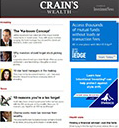Who wants to save for an abstract, unhappy future experience that most people hope will never happen?
You do.
Sixty percent of households said they had experienced a financial shock in the past 12 months when the Pew Charitable Trusts asked in late 2014. Few were prepared, leaving them in even worse shape for the next shock. Some people just don't earn enough to save, but even the 10% of households earning more than $100,000 a year have no cash earmarked as savings, according to a Pew report released today.
Advertisement
We get it. There are bills to pay, vacations to save for, loans to pay off, down payments to amass. And cash earns almost no interest today.
But you don't have to get caught flatfooted in a shock. Below are five ways to avoid some of the potentially harmful financial moves revealed in the report. When Pew looked at where people plan to turn when they need to raise a big chunk of money fast, it turned out most plan to tap checking or savings accounts. That might not cover the cost, and indeed nearly 70% said they'd use "multiple resources." Forty-nine percent would turn to credit; 36% said they'd borrow from someone.
All forms of borrowing come with downsides. Credit card finance charges will add to the debt over time and make paying it off difficult. Borrowing from friends or family can get messy fast, depending on the relationship. Retirement savings should be sacrosanct, though taking a loan from a 401(k) — not cashing it out — is an option. One defensive move homeowners can make is to open a home equity line of credit. The interest rate is likely to be lower than that of a credit card.
Here are suggestions from financial planners for kickstarting an emergency fund and keeping it safe from all the fun things you could do with the money.
Look it in the face, now
The list of possible emergencies is long — dead water heater, major car repair, big medical bills, lost job. "I tell clients that an emergency fund is like your own insurance policy for your cash flow," said Scott Frank, of Stone Steps Financial in Encinitas, Calif. "The funds are available so that you aren't disrupted when life happens — and it will."
Cash can also act as a buffer between you and the financial markets. "If you have six to nine months of cash in an emergency fund, you don't need to be as worried when the markets go down," Mr. Frank said.
Isolate the money
This could mean opening an online savings account at a bank different from where you keep your main checking and savings accounts. Then you can't transfer the money as easily from an emergency fund into checking.
Make that money untouchable. Don't get an ATM card or debit card.
Make it automatic
If possible, sign up for automatic paycheck deposit at work and funnel a set amount per month into the fund. If you're worried about the hit to your cash flow, start small and see if you miss the money. If you don't miss it, increase the amount a little and see how that feels.
If you really want your saving to be on total autopilot, there are online services that can help at digit, or at Betterment, if you want to use a robo-adviser. Based on the pattern of money going in and out of your checking account, the services spirit away chunks of money that they judge you won't miss.
Or create your own system
For those who don't like the idea of automatic deductions, one option is the "dollar per week of the year" approach. In week 1, you save $1; in week 13, you save $13, and so on. Amy Jo Lauber of Lauber Financial Planning, in West Seneca, N.Y., did this but in reverse, saving $52 the first week. (The sum winds up being about $1,400.)
Another way to get started is to challenge yourself to save $500 or $1,000 as quickly as you can, said Mark Beaver of Keeler & Nadler Financial Planning, in Dublin, Ohio. Once you've met that goal, set another short-term goal that can be met relatively quickly. Meeting a series of incremental goals can give you a sense of accomplishment and cheer you on to the next level, said Mr. Beaver. Even better: Take a windfall such as a tax refund or bonus to fund a reserve account immediately.
Use a Roth IRA as an emergency fund
It's smart for young people to contribute the maximum $5,500 to a Roth IRA, said Rose Swanger, a planner in Knoxville, Tenn. That's because the Roth serves a dual purpose. You can save for retirement but also use it without penalty in case of emergency.






